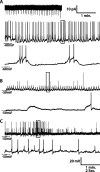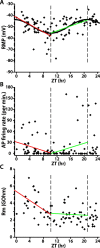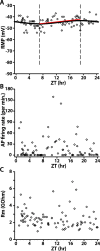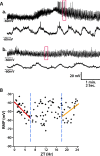Circadian control of membrane excitability in Drosophila melanogaster lateral ventral clock neurons
- PMID: 18562620
- PMCID: PMC2680300
- DOI: 10.1523/JNEUROSCI.1503-08.2008
Circadian control of membrane excitability in Drosophila melanogaster lateral ventral clock neurons
Abstract
Drosophila circadian rhythms are controlled by a neural circuit containing approximately 150 clock neurons. Although much is known about mechanisms of autonomous cellular oscillation, the connection between cellular oscillation and functional outputs that control physiological and behavioral rhythms is poorly understood. To address this issue, we performed whole-cell patch-clamp recordings on lateral ventral clock neurons (LN(v)s), including large (lLN(v)s) and small LN(v)s (sLN(v)s), in situ in adult fly whole-brain explants. We found two distinct sizes of action potentials (APs) in >50% of lLN(v)s that fire APs spontaneously, and determined that large APs originate in the ipsilateral optic lobe and small APs in the contralateral. lLN(v) resting membrane potential (RMP), spontaneous AP firing rate, and membrane resistance are cyclically regulated as a function of time of day in 12 h light/dark conditions (LD). lLN(v) RMP becomes more hyperpolarized as time progresses from dawn to dusk with a concomitant decrease in spontaneous AP firing rate and membrane resistance. From dusk to dawn, lLN(v) RMP becomes more depolarized, with spontaneous AP firing rate and membrane resistance remaining stable. In contrast, circadian defective per(0) null mutant lLN(v) membrane excitability is nearly constant in LD. Over 24 h in constant darkness (DD), wild-type lLN(v) membrane excitability is not cyclically regulated, although RMP gradually becomes slightly more depolarized. sLN(v) RMP is most depolarized around lights-on, with substantial variability centered around lights-off in LD. Our results indicate that LN(v) membrane excitability encodes time of day via a circadian clock-dependent mechanism, and likely plays a critical role in regulating Drosophila circadian behavior.
Figures







References
-
- de Jeu M, Hermes M, Pennartz C. Circadian modulation of membrane properties in slices of rat suprachiasmatic nucleus. NeuroReport. 1998;9:3725–3729. - PubMed
-
- Green DJ, Gillette R. Circadian rhythm of firing rate recorded from single cells in the rat suprachiasmatic brain slice. Brain Res. 1982;245:198–200. - PubMed
-
- Grima B, Chelot E, Xia R, Rouyer F. Morning and evening peaks of activity rely on different clock neurons of the Drosophila brain. Nature. 2004;431:869–873. - PubMed
-
- Groos G, Hendriks J. Circadian rhythms in electrical discharge of rat suprachiasmatic neurones recorded in vitro. Neurosci Lett. 1982;34:283–288. - PubMed
Publication types
MeSH terms
Substances
Grants and funding
LinkOut - more resources
Full Text Sources
Molecular Biology Databases
Research Materials
Miscellaneous
